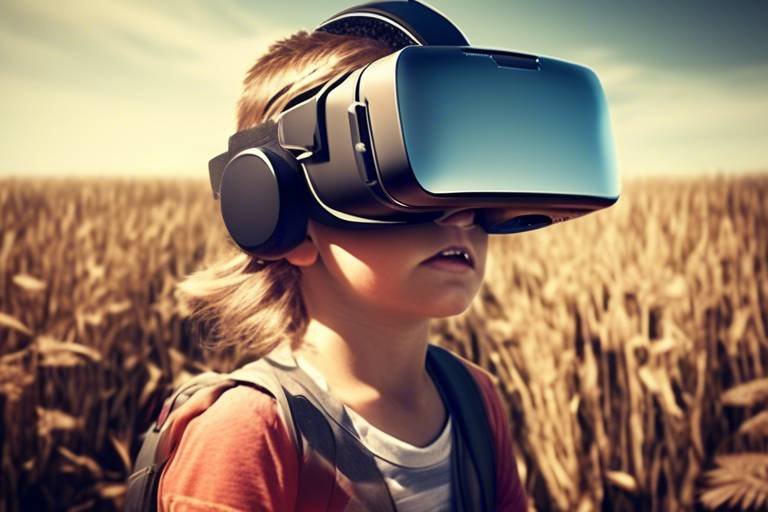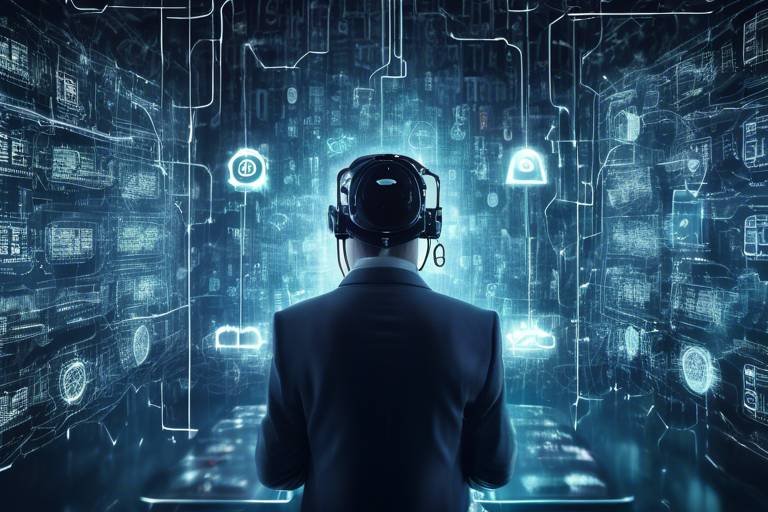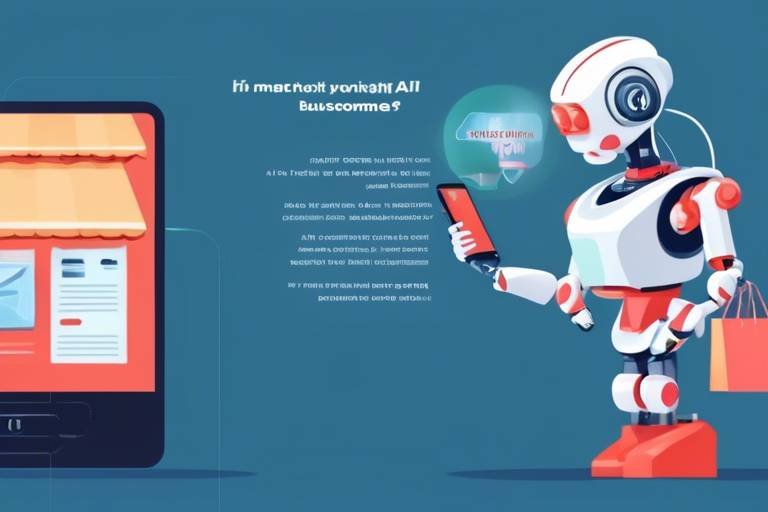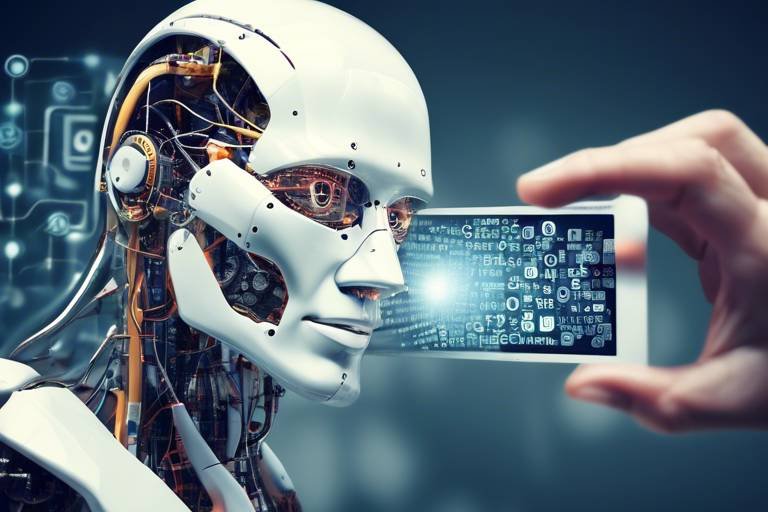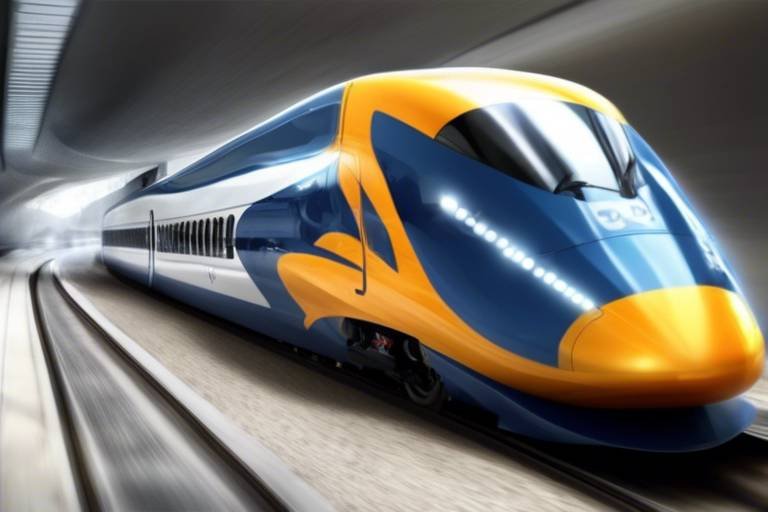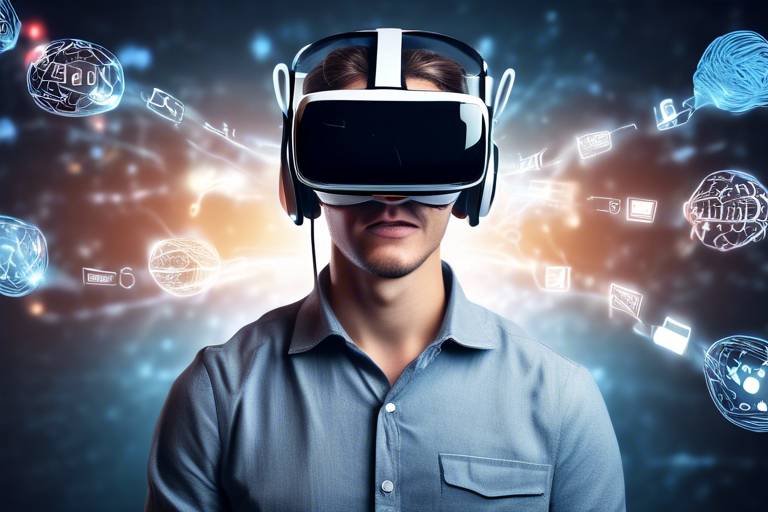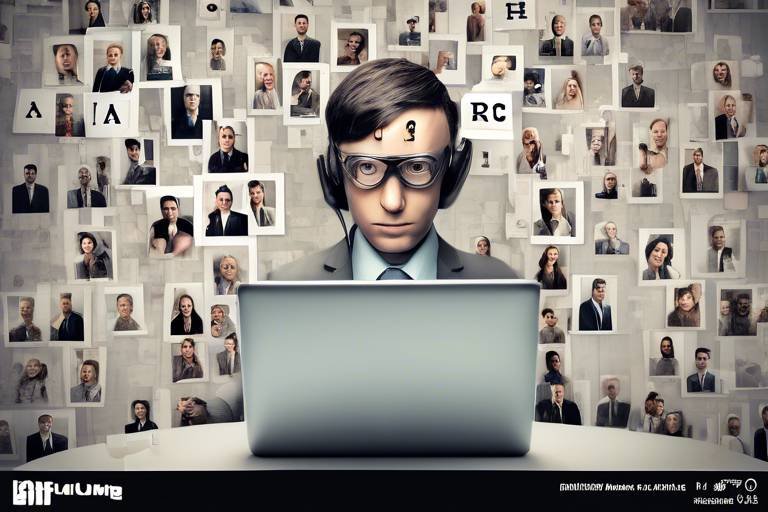Virtual Reality Field Trips: A New Way to Learn
Imagine stepping into a world where the confines of your classroom dissolve, and the wonders of the universe unfold right before your eyes. Virtual Reality (VR) is not just a buzzword; it's a transformative tool that is revolutionizing education. With VR field trips, students are no longer limited to textbooks and videos; they can explore the pyramids of Egypt, dive into the Great Barrier Reef, or walk through the halls of ancient Rome—all without leaving their seats. This immersive technology is enhancing engagement and providing unique opportunities for exploration, making learning an adventure rather than a chore.
The traditional educational landscape often struggles to captivate students' attention. However, VR field trips are changing the game by creating an interactive environment that stimulates curiosity and fosters a deeper understanding of complex subjects. Think of it as a passport to knowledge, where every virtual journey opens a door to new ideas and experiences. This innovative approach not only makes learning more enjoyable but also equips students with the skills they need to thrive in an ever-evolving world.
In this article, we will delve into how VR field trips are reshaping educational experiences, the myriad benefits they offer, and the challenges that still lie ahead. Buckle up, because this journey is just getting started!
Virtual reality offers numerous advantages in education, including increased engagement, improved retention of information, and the ability to experience real-world scenarios without leaving the classroom. Imagine a classroom where students are not just passive recipients of information but active participants in their learning journey. With VR, students can immerse themselves in environments that enhance their understanding and retention of complex subjects.
For instance, studies have shown that students who engage with VR content are more likely to remember what they learned compared to traditional methods. This retention can be attributed to the multi-sensory experience that VR provides, making it easier for students to connect with the material on a personal level. Additionally, VR can cater to various learning styles, allowing visual, auditory, and kinesthetic learners to thrive.
VR field trips utilize advanced technology to create immersive environments, allowing students to explore locations and scenarios that are otherwise inaccessible. These experiences are crafted using sophisticated software and hardware that simulate real-world settings. Students wear VR headsets that transport them to different parts of the world, where they can interact with the environment in real-time.
Through VR, students can interact with their environment, ask questions, and engage in hands-on activities, making learning more dynamic and memorable compared to traditional methods. Imagine being able to dissect a frog in a virtual lab or walk through the Amazon rainforest while learning about biodiversity. This kind of interactive learning experience not only captivates students but also encourages critical thinking and problem-solving skills.
VR technology can provide immediate feedback and assessments, allowing students to understand their learning progress and areas for improvement in real-time. This instant feedback loop is crucial for effective learning, as it helps students identify their strengths and weaknesses, enabling them to adjust their study strategies accordingly.
Virtual reality can facilitate group learning experiences, enabling students to collaborate and solve problems together, fostering teamwork and communication skills. Picture a group of students working together to solve a mystery in a virtual escape room, where they must communicate and strategize to succeed. This collaborative aspect of VR not only enhances learning but also builds essential social skills.
VR field trips break down barriers for students with disabilities or those in remote locations, ensuring that all learners have equal access to enriching educational experiences. Whether it's a student who cannot physically travel due to health issues or one who lives in a rural area with limited educational resources, VR provides a solution that bridges the gap, allowing everyone to participate in the learning process.
From historical landmarks to natural wonders, various VR platforms offer students the chance to explore significant locations around the globe, expanding their cultural and geographical knowledge. Imagine virtually standing at the foot of the Eiffel Tower or swimming with dolphins in the Caribbean. These experiences not only enrich students' understanding of the world but also inspire a sense of wonder and curiosity.
Students can virtually visit ancient civilizations, museums, and historical events, gaining a deeper understanding of history through immersive experiences that textbooks alone cannot provide. This firsthand experience of history allows students to connect with the past in a way that is both engaging and educational.
VR allows students to explore breathtaking natural landscapes, from the depths of the ocean to the peaks of mountains, fostering a sense of wonder and appreciation for the environment. Imagine diving into the vibrant coral reefs or hiking through the majestic Himalayas—all from the comfort of your classroom. Such experiences not only educate but also instill a sense of responsibility toward our planet.
While VR technology has vast potential, there are challenges such as cost, accessibility, and the need for proper training for educators to effectively integrate VR into their teaching practices. The initial investment in VR equipment can be daunting for many schools, and without adequate training, teachers may struggle to utilize this technology to its fullest potential. Addressing these challenges is essential to ensure that VR can be a viable option for all educational institutions.
- What equipment do I need for VR field trips? Most VR field trips require a VR headset and compatible software, which can vary in cost.
- Are VR field trips suitable for all age groups? Yes, VR field trips can be tailored to suit different age groups and educational levels.
- Can VR field trips replace traditional field trips? While VR offers unique experiences, it is best used as a supplement to traditional field trips rather than a complete replacement.
- How do VR field trips enhance learning? VR field trips engage students in immersive experiences, improving retention and understanding of complex subjects.

The Benefits of Virtual Reality in Education
Virtual reality (VR) is not just a buzzword; it's a revolutionary tool that's reshaping the landscape of education. Imagine stepping into a world where you can walk through ancient ruins, dive into the depths of the ocean, or explore the surface of Mars—all without leaving your classroom. The advantages of incorporating VR into educational settings are numerous and impactful. First and foremost, VR significantly boosts engagement. Traditional teaching methods can sometimes feel monotonous, but when students are immersed in a VR experience, their attention is captured like never before. This heightened engagement often leads to a deeper understanding of the material.
Moreover, studies have shown that VR enhances the retention of information. When students can visualize and interact with the subject matter, they are more likely to remember what they've learned. Think about it: when was the last time you forgot a movie you watched in IMAX? The same principle applies to VR in education. By creating a memorable experience, students are more likely to retain knowledge long after the lesson has ended.
Another fantastic benefit of VR in education is the ability to experience real-world scenarios without the logistical headaches of field trips. Imagine a science class studying marine biology being able to virtually explore coral reefs or a history class that can witness the signing of the Declaration of Independence. These immersive experiences not only make learning more exciting but also allow students to connect theoretical knowledge with practical applications.
Additionally, VR can cater to different learning styles. Some students are visual learners, while others thrive on hands-on experiences. VR accommodates these diverse preferences, offering a multi-sensory approach to education. For instance, students can explore a 3D model of the human body, dissecting virtual organs and systems, which is far more engaging than reading a textbook. This adaptability makes VR a powerful tool for inclusive education, ensuring that all students have the opportunity to thrive.
Of course, we can't overlook the potential for collaborative learning. VR platforms often allow multiple students to interact within the same virtual environment. This fosters teamwork and communication skills as students work together to solve problems or complete tasks. Just like in the real world, collaboration is key to success, and VR provides a unique avenue for students to practice these essential skills in a safe and controlled environment.
In conclusion, the benefits of virtual reality in education are vast and varied. From increasing engagement and retention to providing inclusive and collaborative learning experiences, VR is paving the way for a new era of education that transcends traditional boundaries. As technology continues to evolve, the possibilities for VR in education are limitless, making it an exciting time for both educators and students alike.

How VR Field Trips Work
Virtual reality (VR) field trips are revolutionizing the way students engage with their learning environments. Imagine being able to step into a 3D world where you can explore the ancient ruins of Rome or dive into the vibrant coral reefs of Australia—all from the comfort of your classroom. This immersive technology creates a sense of presence that traditional learning methods simply cannot match. By using VR headsets and specialized software, educators can transport students to locations that are often too distant, too dangerous, or too expensive to visit in person.
At the heart of VR field trips is the concept of immersive environments. These environments are created using high-quality graphics and sound, which stimulates the senses and makes learning feel more real. When students don a VR headset, they are not just passive observers; they become active participants in their learning journey. They can look around, interact with objects, and even communicate with virtual characters, which enhances their understanding of the subject matter.
One of the remarkable features of VR field trips is the interactive simulations they offer. For example, a history lesson about the Titanic can transform into a virtual exploration of the ship itself, allowing students to walk through its decks and learn about its design and tragic fate firsthand. This type of experiential learning is proven to increase retention rates because students are more likely to remember experiences that engage them emotionally and intellectually.
Furthermore, VR field trips can provide real-time feedback to students. For instance, while exploring a virtual ecosystem, students might be quizzed on their observations, receiving immediate insights into their understanding of the material. This instant feedback loop not only helps students gauge their progress but also allows educators to tailor their teaching strategies based on the students' needs.
Another exciting aspect of VR field trips is the potential for collaborative learning. Imagine a group of students, each wearing a VR headset, embarking on a virtual journey together. They can work as a team to solve challenges, discuss their findings, and share insights in real-time, regardless of their physical location. This collaborative approach fosters essential skills like teamwork and communication, which are crucial for success in today's interconnected world.
In summary, VR field trips leverage advanced technology to create immersive, interactive, and collaborative learning experiences that enhance student engagement and understanding. By breaking down traditional barriers to education, VR opens up a world of possibilities for students to explore and learn in ways that were once unimaginable.
- What equipment do I need for VR field trips? Typically, you will need a VR headset, a compatible device (like a computer or smartphone), and access to VR content or applications.
- Are VR field trips suitable for all age groups? Yes, VR field trips can be tailored for various age groups, from elementary school students to adults, depending on the content and complexity of the experience.
- Can VR field trips replace traditional field trips? While VR can enhance learning experiences, it is best used as a complement to traditional field trips rather than a complete replacement.
- How can teachers integrate VR into their curriculum? Teachers can start by selecting VR experiences that align with their lesson plans and gradually incorporate them into classroom activities.

Interactive Learning Experiences
Imagine stepping into a world where learning is not confined to the four walls of a classroom. With virtual reality (VR), students can embark on thrilling adventures that turn mundane lessons into captivating explorations. This technology allows learners to interact with their surroundings in ways that traditional methods simply cannot match. Picture this: instead of reading about the solar system in a textbook, students can float among the stars, examining planets up close and personal. The thrill of discovery becomes a tangible experience, and that’s what makes VR so powerful in education.
One of the most exciting aspects of VR is the ability to engage students in hands-on activities. For instance, during a virtual science experiment, students can mix chemicals in a simulated lab environment without the risk of accidents. They can observe reactions, adjust variables, and even repeat experiments at the click of a button. This level of interactivity not only enhances understanding but also boosts retention. When students actively participate in their learning, they are more likely to remember what they’ve experienced.
Furthermore, VR creates opportunities for collaborative learning. Imagine a group of students exploring a virtual rainforest together. They can communicate, share observations, and work as a team to solve challenges presented in the simulation. This kind of collaborative experience fosters essential skills such as teamwork and communication, preparing students for real-world scenarios. The interactive nature of VR encourages students to ask questions and engage in discussions, making learning a social experience rather than a solitary one.
In addition to enhancing engagement, VR provides real-time feedback. As students navigate through their virtual environments, they can receive immediate assessments of their performance. For example, if a student is exploring a historical site, they might answer questions about what they see. The VR system can instantly inform them if their answers are correct or if they need to revisit certain concepts. This immediate feedback loop is invaluable, as it allows students to identify areas for improvement on the spot, fostering a growth mindset.
Ultimately, the interactive learning experiences offered by VR are transforming education into a dynamic and engaging journey. Students are no longer passive recipients of information; they are explorers, scientists, and historians in their own right. By immersing them in environments where they can interact, collaborate, and receive feedback, we are not just teaching them facts—we are igniting their passion for learning. The future of education is here, and it’s more exciting than ever.

Real-Time Feedback
One of the most exciting aspects of virtual reality (VR) in education is its ability to provide . Imagine being in a classroom where every question you ask gets an immediate response, and your understanding of a subject can be assessed on the spot. This is not just a dream; it's a reality with VR technology. When students engage in a VR field trip, they can interact with the environment and receive instant feedback on their actions. For instance, if a student is exploring an ancient civilization, they can touch artifacts and receive information about their historical significance right away. This dynamic interaction not only keeps learners engaged but also helps solidify their understanding of complex concepts.
Moreover, real-time feedback allows educators to monitor students' progress during these immersive experiences. Teachers can see which areas students are excelling in and which ones might need more attention. This is crucial in tailoring educational experiences to meet individual learning needs. For example, if a group of students struggles with the concept of gravity while exploring a VR simulation of the solar system, the system can provide additional resources or alternative explanations based on their interactions. This level of personalized learning is a game-changer, making education more effective than ever.
Additionally, real-time feedback can come in various forms. It can be verbal, visual, or even through gamified elements that reward students for correct answers or successful interactions. This immediate reinforcement encourages a growth mindset, where students feel motivated to learn from their mistakes and continuously improve. By seeing the results of their actions instantly, students are more likely to stay engaged and curious, turning learning into an adventure rather than a chore.
To illustrate the impact of real-time feedback in VR, consider the following table that compares traditional learning methods with VR-enhanced learning:
| Aspect | Traditional Learning | VR Learning |
|---|---|---|
| Feedback Timing | Delayed (after assignments or tests) | Immediate (during the learning experience) |
| Engagement Level | Moderate | High (immersive and interactive) |
| Personalization | Limited | Highly personalized based on interactions |
| Learning Retention | Lower | Higher due to immersive experiences |
As we can see, the advantages of real-time feedback in VR learning are profound. It not only enhances engagement but also significantly improves retention of knowledge. In a world where information is abundant but attention spans are dwindling, VR offers a solution that captivates and educates simultaneously. So, why not embrace this innovative approach to learning? The future of education is here, and it’s more interactive than ever!
- What is virtual reality in education? Virtual reality in education refers to the use of immersive technology that allows students to experience learning environments and scenarios that enhance their understanding and engagement.
- How does real-time feedback work in VR? Real-time feedback in VR provides immediate responses to students' actions, allowing them to understand their learning progress and make adjustments on the spot.
- Can VR field trips be used for all subjects? Yes, VR field trips can be tailored to various subjects, including history, science, geography, and more, making them a versatile educational tool.
- Are VR field trips accessible to all students? While VR technology is becoming more accessible, there are still challenges related to cost and availability that need to be addressed to ensure all students can benefit from these experiences.

Collaborative Learning Opportunities
Virtual Reality (VR) is not just about immersing students in a solitary experience; it opens up a whole new world of . Imagine a classroom where students from different parts of the world can come together in a virtual space, working on projects and solving problems as if they were in the same room. This is the magic of VR. It allows learners to engage with one another, share ideas, and tackle challenges collectively, breaking down the barriers of distance and physical limitations.
In a VR environment, students can participate in group activities that require teamwork, fostering essential skills such as communication, negotiation, and critical thinking. For instance, they might be tasked with solving a mystery in a historical setting, where each student takes on a different role, contributing unique insights based on their research or perspective. This kind of interactive learning not only enhances their understanding of the subject matter but also builds camaraderie among peers, making education a more enriching experience.
Moreover, VR platforms often include tools that facilitate real-time collaboration. Students can share their findings, present ideas, and receive feedback instantly, creating a dynamic atmosphere of learning. This immediacy can be incredibly motivating, as learners see the direct impact of their contributions. Imagine a scenario where a group of students is exploring the Great Barrier Reef together. They can discuss marine life, share observations, and even work together on a conservation project—all from the comfort of their own homes.
To illustrate the potential of VR in collaborative learning, consider the following table that highlights some key features:
| Feature | Description |
|---|---|
| Real-Time Interaction | Students can communicate and collaborate seamlessly, regardless of their physical location. |
| Role Assignments | Participants can take on different roles within a project, enhancing engagement and accountability. |
| Shared Resources | Students can access and share digital resources, making research and project work more efficient. |
| Feedback Mechanisms | Instant feedback helps students adjust their approaches and improve their work in real-time. |
In summary, VR not only transforms how students learn individually but also revolutionizes the way they collaborate with one another. By providing a platform for joint exploration and problem-solving, VR cultivates a sense of community and shared purpose among learners. As we continue to embrace this technology, the potential for collaborative learning is boundless, paving the way for a more inclusive and engaging educational landscape.
- What is virtual reality in education? Virtual reality in education refers to the use of VR technology to create immersive learning experiences that enhance engagement and understanding.
- How can VR enhance collaborative learning? VR allows students to interact in real-time, share ideas, and work together on projects, regardless of their physical location.
- Are VR field trips accessible for all students? Yes, VR field trips can provide equal access to educational experiences for students with disabilities and those in remote locations.
- What are some popular VR field trip destinations? Students can explore historical sites, natural wonders, and even space through various VR platforms.

Accessibility and Inclusivity in Education
In today's diverse educational landscape, accessibility and inclusivity are paramount. Virtual reality (VR) field trips are revolutionizing the way we think about these concepts. Imagine a classroom where every student, regardless of their physical abilities or location, can embark on a journey to the Great Wall of China or dive into the Great Barrier Reef. This is not just a dream; it's becoming a reality with VR technology.
One of the most significant advantages of VR is its ability to break down barriers that traditionally hinder learning experiences. For students with disabilities, conventional field trips can pose numerous challenges, from transportation issues to physical accessibility at the destination. However, VR field trips allow these students to participate fully without the logistical headaches. They can engage with their peers, explore new environments, and absorb knowledge in a way that is both exciting and accessible.
Moreover, students in remote areas often miss out on enriching experiences due to geographical limitations. With VR, the world is literally at their fingertips. They can explore cultural landmarks, attend virtual science fairs, or even participate in collaborative projects with students from different countries. This exposure fosters a sense of global citizenship and broadens their horizons, making education a truly inclusive endeavor.
To illustrate the impact of VR on accessibility and inclusivity, consider the following table that outlines the traditional challenges versus the advantages offered by VR:
| Traditional Challenges | VR Advantages |
|---|---|
| Physical limitations for students with disabilities | Fully immersive experiences without physical barriers |
| Geographical limitations for remote learners | Access to global destinations from the classroom |
| Logistical issues in organizing field trips | Instant access to multiple environments at any time |
| Limited engagement for students with different learning needs | Interactive and customizable learning experiences |
By embracing VR technology, educators are not only enhancing the learning experience but also promoting a culture of inclusivity. Students are encouraged to collaborate and share their insights, fostering a sense of belonging that is essential for effective learning. Whether it’s working together on a virtual project or discussing findings from a simulated archaeological dig, VR creates opportunities for teamwork that transcend physical limitations.
In conclusion, VR field trips are a game-changer in making education accessible and inclusive. They empower all students to engage with the world around them, regardless of their circumstances. As we continue to explore the possibilities that VR offers, we can look forward to a future where every learner has the chance to thrive and discover.
- What is virtual reality in education? Virtual reality in education refers to the use of immersive technology to create engaging learning experiences that allow students to explore environments and scenarios that are not easily accessible in real life.
- How does VR enhance accessibility? VR enhances accessibility by providing equal opportunities for all students, including those with disabilities or those living in remote areas, to participate in enriching educational experiences.
- Are there any challenges with implementing VR in schools? Yes, challenges include the cost of technology, the need for training educators, and ensuring that all students have access to the necessary equipment.
- What are some popular VR field trip destinations? Popular destinations include historical sites, natural wonders, museums, and cultural landmarks around the world.

Popular VR Field Trip Destinations
When it comes to virtual reality (VR) field trips, the world truly becomes your classroom. Imagine exploring the ancient ruins of Machu Picchu or diving into the Great Barrier Reef without ever leaving your seat! These immersive experiences are not just about seeing; they’re about feeling the essence of these locations as if you were really there. With VR technology, students can embark on journeys to various significant locations across the globe, expanding their cultural and geographical knowledge in ways that traditional learning simply cannot match.
One of the most exciting aspects of VR field trips is the ability to visit historical landmarks. For instance, students can take a virtual stroll through the Pyramids of Giza, exploring the intricate details of these ancient structures while learning about the civilization that built them. This type of engagement fosters a deeper understanding of history, as students can visualize and contextualize events that shaped our world. Imagine standing in the midst of a bustling medieval market or witnessing the signing of the Declaration of Independence—all from the comfort of your classroom!
Moreover, VR opens doors to natural wonders that would otherwise be unreachable for many students. Picture yourself soaring over the majestic Grand Canyon or swimming alongside vibrant coral reefs. These experiences not only evoke awe but also instill a sense of responsibility towards preserving our planet. As students explore these stunning landscapes, they become more aware of environmental issues and the importance of conservation. The emotional connection formed during these virtual explorations can motivate young minds to become stewards of the Earth.
In addition to historical and natural sites, VR platforms also offer access to significant cultural landmarks. Students can visit the Colosseum in Rome or the Great Wall of China, absorbing rich histories and diverse cultures. This exposure to global heritage encourages empathy and understanding among students, as they learn about different ways of life and the stories that shape them. The ability to experience these locations firsthand, even virtually, allows students to appreciate the vast tapestry of human history and culture.
To summarize, VR field trips provide a unique opportunity for students to explore the world in a way that textbooks and videos simply cannot replicate. They engage learners with interactive experiences, making education exciting and memorable. As technology continues to evolve, the possibilities for virtual exploration are boundless, promising an exciting future for educational experiences.
- What is a VR field trip?
A VR field trip is an immersive educational experience that allows students to explore various locations and scenarios through virtual reality technology. - How does VR enhance learning?
VR enhances learning by providing engaging, interactive experiences that improve retention and understanding of complex subjects. - Are VR field trips accessible for all students?
Yes, VR field trips can be designed to accommodate students with disabilities and those in remote locations, ensuring equal access to educational experiences. - What are some popular VR field trip destinations?
Popular destinations include historical sites like the Pyramids of Giza, natural wonders like the Grand Canyon, and cultural landmarks like the Colosseum in Rome.

Exploring Historical Sites
Imagine stepping into the shoes of a Roman soldier, walking through the bustling streets of ancient Rome, or standing before the majestic pyramids of Giza. With virtual reality, these experiences are not just fantasies; they are immersive journeys that students can embark on from the comfort of their classrooms. VR technology transports learners to significant historical sites, allowing them to witness and interact with moments in history that textbooks can only describe. This innovative approach to education opens up a world of possibilities for understanding our past.
When students engage with historical sites through VR, they gain a multi-dimensional perspective that enhances their learning experience. For instance, while exploring the ruins of Pompeii, learners can not only view the remnants of ancient architecture but also visualize the eruption of Mount Vesuvius and its impact on the city. Such immersive experiences foster a deeper emotional connection to history, making it more relatable and memorable.
Additionally, VR can provide context that traditional learning methods often lack. Students can explore the historical significance of various locations and understand their cultural relevance. For example, a virtual tour of the Berlin Wall allows students to grasp the profound implications of its construction and eventual fall, while also learning about the lives affected by this division.
To illustrate the diverse historical sites available for exploration through VR, here’s a brief overview of some popular destinations:
| Historical Site | Location | Significance |
|---|---|---|
| Ancient Rome | Italy | Capital of the Roman Empire, rich in architecture and culture |
| Pyramids of Giza | Egypt | One of the Seven Wonders of the Ancient World |
| Great Wall of China | China | Symbol of China's historical strength and architectural ingenuity |
| Berlin Wall | Germany | Representation of the Cold War and the division of East and West |
Through these virtual explorations, students can participate in guided tours led by historians or archaeologists, asking questions and gaining insights that deepen their understanding. The interactive nature of VR allows for a dynamic learning environment where students can engage with the material actively rather than passively absorbing information.
In conclusion, exploring historical sites through virtual reality is not just about seeing the past; it's about experiencing it. This technology transforms history from a static subject into a vibrant, living narrative that students can connect with on a personal level. As they journey through time and space, they develop a greater appreciation for the world’s rich tapestry of cultures and events, preparing them to become informed global citizens.
- What is virtual reality? Virtual reality (VR) is a technology that creates a simulated environment, allowing users to immerse themselves in a 3D space and interact with it.
- How can VR enhance learning? VR enhances learning by providing immersive experiences that increase engagement, improve retention, and offer real-world scenarios for exploration.
- Are VR field trips accessible to all students? Yes, VR field trips can be designed to be inclusive, providing opportunities for students with disabilities or those in remote areas to access enriching educational experiences.
- What are some popular VR field trip destinations? Some popular destinations include ancient Rome, the Great Wall of China, and the pyramids of Giza.

Discovering Natural Wonders
Imagine standing on the edge of the Grand Canyon, feeling the cool breeze on your face as you gaze into the vast expanse of layered rock formations that tell a story millions of years in the making. With virtual reality (VR), students can experience such breathtaking natural wonders without ever leaving their classrooms. This technology opens up a world of exploration, allowing learners to traverse the globe and witness the beauty of our planet in a way that textbooks simply can't convey.
Through VR, students can dive into the depths of the ocean, exploring vibrant coral reefs teeming with life. They can hike up the majestic peaks of the Himalayas, feeling a sense of achievement as they reach the summit. Such experiences not only foster a sense of wonder but also deepen their understanding of environmental science, geography, and the importance of conservation. By virtually visiting these awe-inspiring locations, students can develop a profound appreciation for the natural world.
Moreover, VR field trips can be designed to include interactive elements. For instance, students might be tasked with identifying various species of plants and animals in a rainforest or completing challenges that teach them about ecosystems. This hands-on approach makes learning dynamic and engaging, ensuring that students are not just passive observers but active participants in their educational journey.
To illustrate the potential of VR in discovering natural wonders, consider the following table showcasing some popular virtual destinations:
| Destination | Description | Learning Opportunities |
|---|---|---|
| The Great Barrier Reef | Explore the world's largest coral reef system. | Marine biology, ecosystem dynamics, conservation efforts. |
| Mount Everest | Experience a virtual climb to the highest peak on Earth. | Geography, climate change, physical endurance. |
| Amazon Rainforest | Dive into the heart of one of the most biodiverse places on the planet. | Ecology, biodiversity, indigenous cultures. |
As students embark on these virtual adventures, they can also engage in group discussions, sharing their insights and reflections. This collaborative aspect not only enhances their learning experience but also fosters teamwork and communication skills. It's an opportunity for them to connect with their peers, discuss their findings, and even debate the importance of preserving these natural wonders for future generations.
In conclusion, discovering natural wonders through VR is not just about seeing beautiful places; it's about creating an emotional connection with our planet. These experiences can inspire students to become stewards of the Earth, encouraging them to take action in their communities and beyond. With the world at their fingertips, the possibilities for exploration and learning are truly limitless.
- What is virtual reality? Virtual reality (VR) is a technology that creates a simulated environment, allowing users to experience and interact with a 3D world.
- How can VR enhance education? VR enhances education by providing immersive experiences that increase engagement, improve retention, and allow for real-world simulations.
- Are VR field trips accessible to all students? Yes, VR can provide opportunities for students with disabilities or those in remote locations to experience educational content that may otherwise be inaccessible.
- What are some popular VR field trip platforms? Some popular platforms include Google Expeditions, Nearpod, and Oculus Education, each offering various immersive experiences.

Challenges and Limitations of VR in Education
While the potential of Virtual Reality (VR) in education is undeniably exciting, there are several challenges and limitations that educators and institutions face when attempting to implement this technology. One of the most significant hurdles is the cost associated with VR equipment and software. High-quality VR headsets and the necessary hardware can be quite expensive, making it difficult for many schools, particularly those in low-income areas, to afford these resources. Furthermore, the ongoing costs of software licenses and updates can add to the financial burden.
Another challenge is accessibility. Not all students have equal access to technology, and this disparity can create a divide in educational opportunities. Students from different backgrounds may not have the same access to VR devices at home, which can hinder their ability to fully engage with VR learning experiences. Moreover, students with disabilities may face additional barriers when using VR technology, requiring specialized equipment or adaptations that are not always available in every educational setting.
The need for proper training for educators is also a critical limitation. Many teachers may not be familiar with how to effectively integrate VR into their lesson plans or how to troubleshoot technical issues that arise during use. Without adequate training and support, the technology may not be utilized to its fullest potential, leading to frustration for both educators and students. Additionally, the rapid pace of technological advancement means that educators must continually update their skills and knowledge, which can be overwhelming.
Moreover, there are concerns regarding the health and safety of students when using VR technology. Extended use of VR headsets can lead to discomfort, eye strain, and even motion sickness in some individuals. This raises questions about how long students should be engaged in VR experiences and whether there should be guidelines in place to ensure their well-being.
In summary, while VR offers a revolutionary approach to education, addressing these challenges is essential for its successful implementation. Educational institutions must consider the financial implications, ensure equitable access, provide adequate training for teachers, and prioritize student health to fully harness the benefits of VR technology.
- What is Virtual Reality in education?
Virtual Reality in education refers to the use of VR technology to create immersive learning experiences, allowing students to explore and interact with virtual environments that enhance their understanding of various subjects. - How can VR improve student engagement?
VR can significantly boost student engagement by providing interactive and hands-on experiences that traditional learning methods often lack, making lessons more enjoyable and memorable. - Are there any health risks associated with using VR in education?
Yes, prolonged use of VR headsets can lead to discomfort, eye strain, and motion sickness. It’s important for educators to monitor usage time and provide breaks to ensure student well-being. - What are some popular VR platforms for educational field trips?
Some popular VR platforms include Google Expeditions, Nearpod, and Oculus for Business, which offer a variety of immersive experiences for students to explore.
Frequently Asked Questions
- What is a virtual reality field trip?
A virtual reality field trip is an immersive educational experience that allows students to explore various locations and scenarios through VR technology. Instead of just reading about a place or event, students can actually "visit" it, enhancing their understanding and engagement.
- How does virtual reality enhance learning?
Virtual reality enhances learning by providing an interactive platform where students can experience real-world scenarios. This increased engagement leads to better retention of information, as students are more likely to remember what they’ve actively participated in rather than passively learned.
- Are VR field trips accessible for all students?
Yes! VR field trips are designed to be inclusive, breaking down barriers for students with disabilities or those in remote areas. This technology ensures that every learner has the opportunity to experience enriching educational content, regardless of their circumstances.
- What are some popular destinations for VR field trips?
Popular destinations include historical landmarks like the Great Wall of China, natural wonders such as the Grand Canyon, and even museums around the world. These virtual experiences allow students to explore significant cultural and geographical sites without leaving their classrooms.
- What challenges does VR face in education?
While VR has immense potential, there are challenges such as high costs, limited accessibility for some schools, and the need for teacher training. Educators must be equipped to effectively integrate VR into their curricula to maximize its benefits.
- Can students interact with their VR environment?
Absolutely! One of the key features of VR field trips is the ability for students to interact with their surroundings. They can ask questions, engage in hands-on activities, and collaborate with peers, making the learning experience much more dynamic and memorable.
- How does VR provide real-time feedback?
VR technology can offer immediate assessments and feedback during the learning process. This allows students to understand their progress and identify areas for improvement right away, fostering a more effective learning environment.

